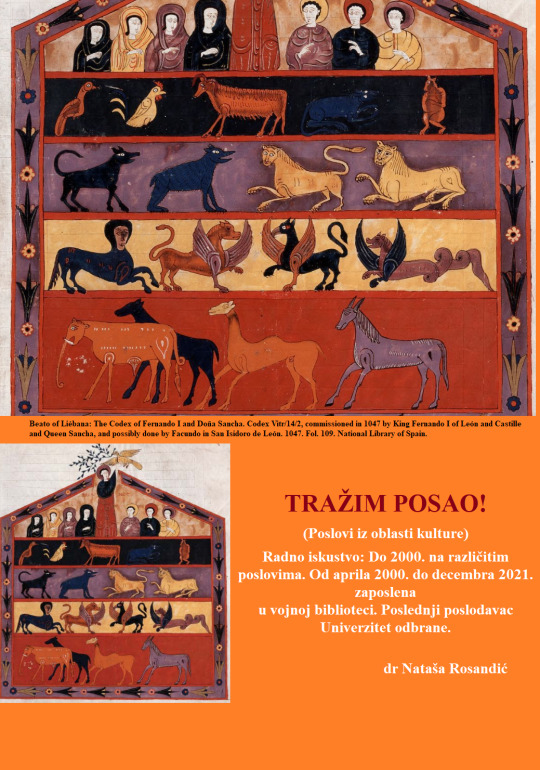#beatus of liébana
Photo

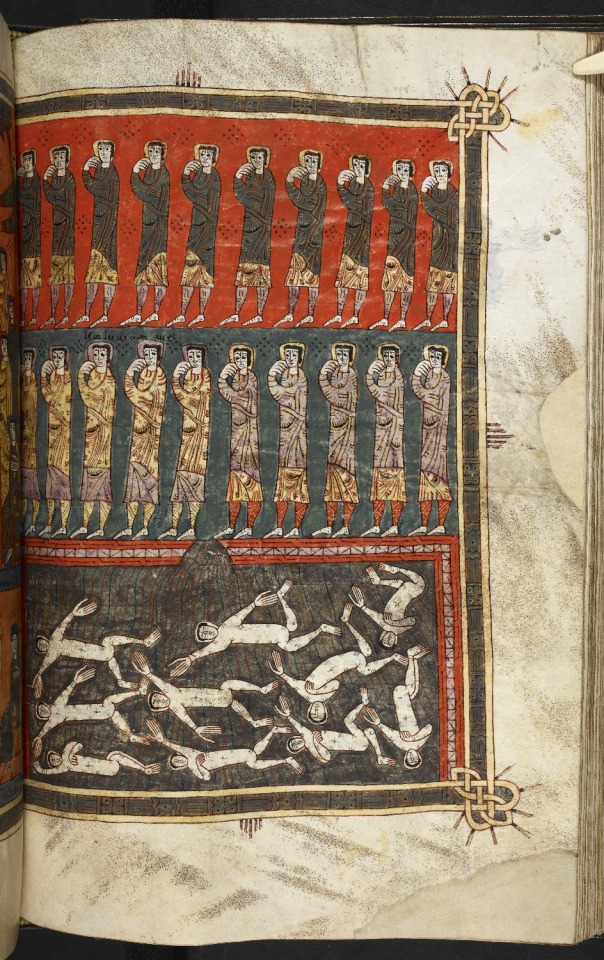
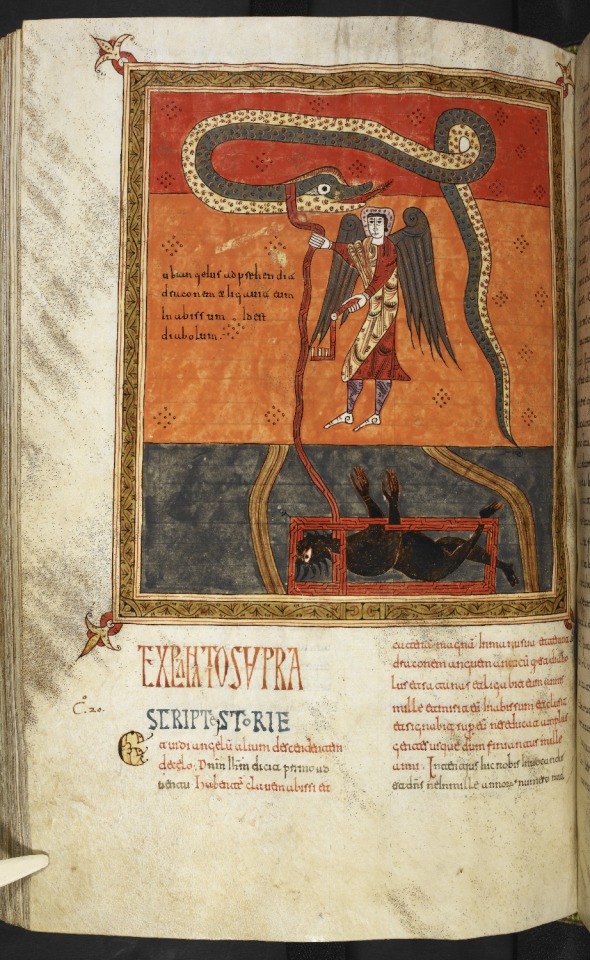



Beatus of Liébana, Commentary on the Apocalypse, Northern Spain, end of 10th century
Pages depicting the Last Judgement (top), the angel enchaining Satan (Revelation 20:1-3, middle left), angels restraining the four winds (Revelation 7:1-3, middle right), and the 144,000 chosen from the twelve tribes of Israel (Revelation 7:4-12, bottom)
British Library Catalogue of Illuminated Manuscripts (Additional 11695)
3K notes
·
View notes
Text


mappa mundi
from the "rylands beatus", a copy of beatus of liébana's 8th c. commentary on the apocalypse of st john, spain, late 12th or early 13th c.
source: Manchester, John Rylands Library, Latin MS 8, fol. 43v-44r
#12th century#13th century#mappa mundi#maps#rylands beatus#beatus of liébana#apocalypse#adam and eve#medieval maps#medieval art
102 notes
·
View notes
Text
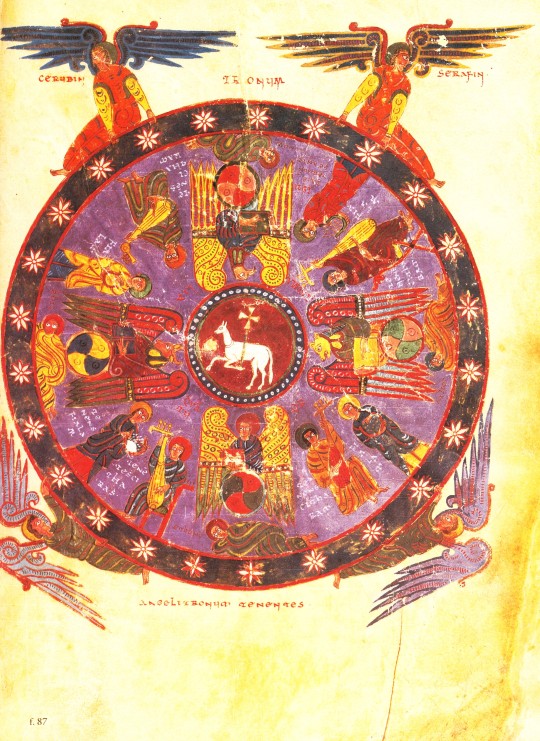

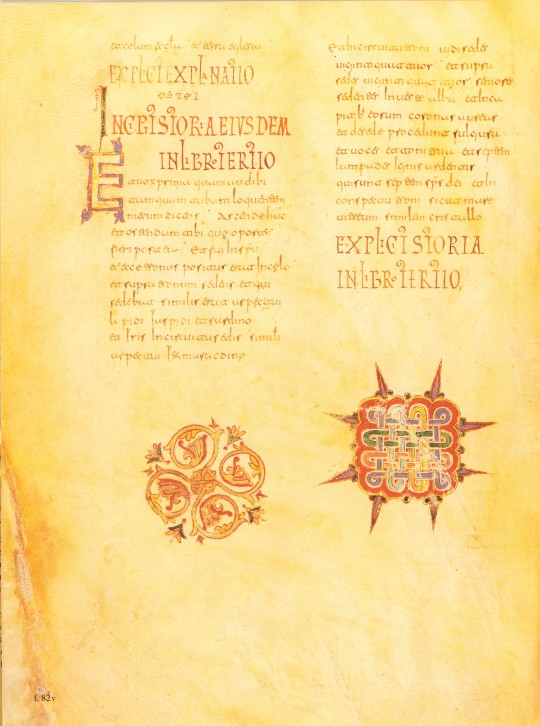
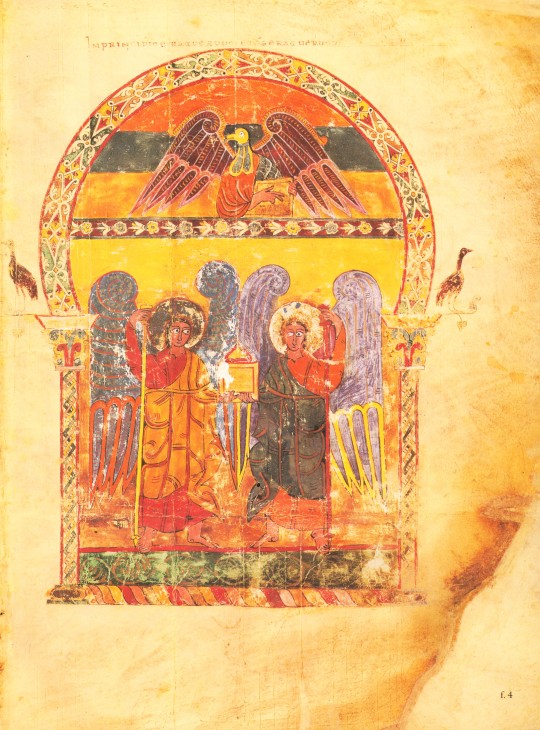




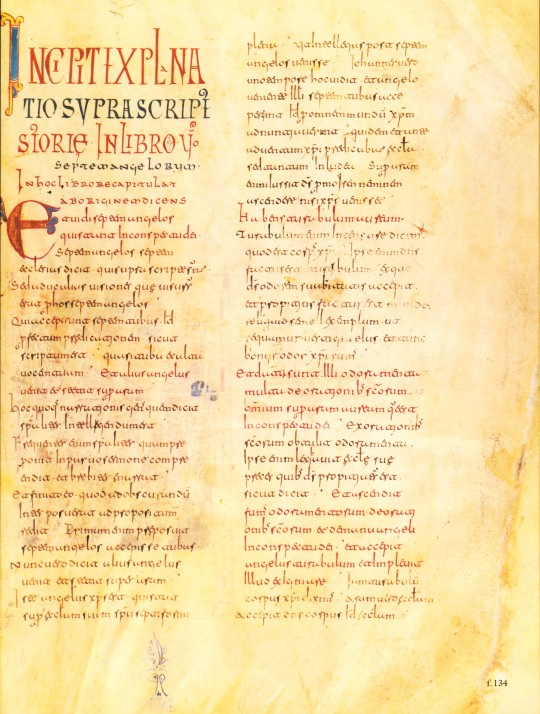
Welcome to Manuscript Monday!
In this series we will periodically focus on selections from our manuscript facsimile collection. Today we present selections from the Morgan Beatus Manuscript, reproduced as A Spanish Apocalypse, The Morgan Beatus Manuscript in New York by George Braziller, Inc. in association with the Pierpont Morgan Library in 1991. The original manuscript, made around 10th century CE at the scriptorium of San Miguel de Escalada in Spain by a monk named Maius, is the earliest surviving illuminated version of the monk Beatus of Liébana's commentary on the biblical Book of Apocalypse (also known as the Book of Revelation). The text of the Book of Revelation makes up the first part of the manuscript, and Beatus’s commentary comprises the second part. The Book of Revelation tells of the end-times in Christianity, during the final judgement of humanity by God. The story within this Biblical book was also seen by those living during the Latin medieval era as representative of the beginning of something new: God’s celestial kingdom. Due to this view of the book, many artists incorporated imagery from this part of the Bible in their work.
Produced in Al-Andalus, or Muslim-ruled Spain, the artistic style of this work combines both Muslim and Christian visual traditions to create a beautifully illuminated manuscript that supplements the commentary by the monk. This artistic style is known as the Mozarabic, which comes from the Arabic mustaʿrib, meaning ‘Arabicized’. Interestingly, this style of art can only be seen in Christian religious art and architecture from Spain at the time, as non-religious artistic objects made by Christians look so similar to Islamic versions of the same works that they cannot be identified as intentionally Christian. Some key Islamic artistic elements within the manuscript include buildings with horseshoe arches, intricate geometric and vegetal patterns as borders for larger images, and the large, bulging eyes of the illustrated animals.
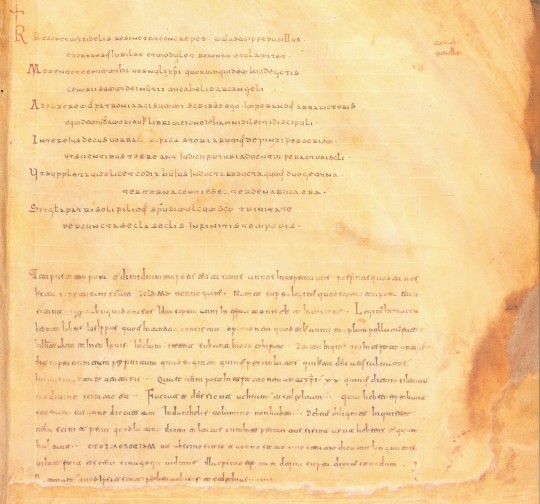
Another interesting aspect of this specific manuscript is the colophon at the end of the manuscript. It tells readers about the circumstances surrounding the creation of this book, including the maker, the patron, the year it was made, and an explanation about why Maius created the manuscript ("I write this . . . at the command of Abbot Victor, out of love for the book of the vision of John the beloved disciple. As part of its adornment I have painted a series of pictures . . . so that the wise may fear the coming of the future judgement of the world's end."). Colophons in medieval manuscripts are not usually as detailed, so the inclusion of all this information contributes greatly to the knowledge and history surrounding the Morgan Beatus Manuscript.
View more Manuscript Monday posts.
– Sarah S., Special Collections Graduate Intern
#manuscript monday#manuscripts#morgan library#morgan beatus manuscript#Beatus of Liébana#Spain#Christian art#Mozarabic#Islamic art style#facsimilies#Spanish art#Medieval art#Spanish medieval art#A Spanish Apocalypse#George Braziller#illuminated manuscripts#Sarah S.
132 notes
·
View notes
Text

Me: When I have the opportunity to talk freely and wholly unhinged about my blorbo.
1 note
·
View note
Photo

MINIATURIST, Spanish
Beatus of Liébana: Commentary on the Revelation of St. John
before 1000
Manuscript (Cod. & II. 5), 395 x 225 mm
Real Biblioteca de San Lorenzo, El Escorial
141 notes
·
View notes
Text
the name of the rose enjoyers: free metropolitan museum of art pdf analyzing and contrasting the beatus of liébana apocalypse manuscripts including an analysis of pigment & production
30 notes
·
View notes
Text

Leaf from a Beatus Manuscript: the Lamb at the Foot of the Cross, Flanked by Two Angels; The Calling of Saint John with the Enthroned Christ flanked by Angels and a Man Holding a Book (Spain, c 1180 CE). Illustrated Beatus manuscripts bring to life an extraordinary vision of the end of the world, as recorded by Saint John in the Apocalypse (Book of Revelation) and filtered through the lens of Beatus of Liébana, an eighth-century Asturian monk. These manuscripts are unique to medieval Spain and a testament to the artistry and intellectual milieu of monastic culture there. The leaf shown here comes from a manuscript that was disassembled in the 1870s.
This frontispiece image depicts a lamb (an image commonly associated with Christ) tormented by the spear and sponge used against Christ during the Passion. The alpha and omega symbols hanging from the cross refer to a passage from the Apocalypse: "Ἐγώ εἰμι τὸ Ἄλφα καὶ τὸ Ὦ, λέγει κύριος, ὁ θεός, ὁ ὢν καὶ ὁ ἦν καὶ ὁ ἐρχόμενος, ὁ παντοκράτωρ." (that is: "I am Alpha and Omega, the beginning and the end, saith the Lord God, who is, and who was, and who is to come, the Almighty") (Apoc. 1:8)
[Robert Scott Horton]
* * * * *
“To hear is to let the sound wander all the way through the labyrinth of your ear; to listen is to travel the other way to meet it. It’s not passive but active, this listening. It’s as though you retell each story, translate it into the language particular to you, fit it into your cosmology so you can understand and respond, and thereby it becomes part of you. To empathize is to reach out to meet the data that comes through the labyrinths of the senses, to embrace it and incorporate it. To enter into, we say, as though another person’s life was also a place you could travel to.”
― Rebecca Solnit, The Faraway Nearby
[via "alive on all channels"]
#Easter#the cross#Lamb#Beatus Manuscript#angels#apocalypse#eighth century#religious art#Rebecca Solnit#quotes#Alive on All Channels#The Faraway Nearby
6 notes
·
View notes
Photo

Beatus of Liébana, Commentaria in Apocalypsin (the ‘Beatus of Saint-Sever’), Saint-Sever before 1072
187 notes
·
View notes
Text
Monopods
Monopods (also called sciapods, skiapods, skiapodes) were mythological dwarf-like creatures with a single, large foot extending from a leg centred in the middle of their bodies. The names monopod and skiapod (σκιάποδες) are both Greek, respectively meaning "one-foot" and "shadow-foot".

Monopods appear in Aristophanes' play The Birds, first performed in 414 BC. They are described by Pliny the Elder in his Natural History, where he reports travelers' stories from encounters or sightings of Monopods in India. Pliny remarks that they are first mentioned by Ctesias in his book Indika, a record of the view of Persians of India which only remains in fragments. Pliny describes Monopods like this:
He [Ctesias] speaks also of another race of men, who are known as Monocoli, who have only one leg, but are able to leap with surprising agility. The same people are also called Sciapodae, because they are in the habit of lying on their backs, during the time of the extreme heat, and protect themselves from the sun by the shade of their feet.
Philostratus mentions Skiapodes in his Life of Apollonius of Tyana, which was cited by Eusebius in his Treatise Against Hierocles. Apollonius of Tyana believes the Skiapodes live in India and Ethiopia, and asks the Indian sage Iarkhas about their existence.
St. Augustine (354–430) mentions the "Skiopodes" in The City of God, Book 16, Chapter 8 entitled "Whether Certain Monstrous Races of Men Are Derived From the Stock of Adam or Noah's Sons", and mentions that it is uncertain whether such creatures exist.
Reference to the legend continued into the Middle Ages, for example with Isidore of Seville in his Etymologiae, where he writes:
The race of Sciopodes are said to live in Ethiopia; they have only one leg, and are wonderfully speedy. The Greeks call them σκιαπόδες ("shade-footed ones") because when it is hot they lie on their backs on the ground and are shaded by the great size of their foot.
The Hereford Mappa Mundi, drawn c. 1300, shows a sciapod on one side of the world, as does a world map drawn by Beatus of Liébana (c. 730 – c. 800).
A race of the "One-Legged",or the "Uniped" was allegedly encountered by Thorfinn Karlsefni and his group of Icelandic settlers in North America in the early 11th century, according to the Saga of Erik the Red. The presence of "unipedes maritimi" in Greenland was marked on Claudius Clavus's map dated 1427.
According to the saga, Karlsefni Thorvald Eiriksson and others assembled a search party for Thorhall, and sailed around Kjalarnes and then south. After sailing for a long time, while moored on the south side of a west-flowing river, they were shot at by a one-footed man (einfœtingr), and Thorvald died from an arrow wound.
The saga goes on to relate that the party went northward and approached what they guessed to be Einfœtingaland ("Land of the One-Legged" or "Country of the Unipeds").
According to Carl A. P. Ruck, the Monopods's cited existence in India refers to the Vedic Aja Ekapad ("Not-born Single-foot"), an epithet for Soma. Since Soma is a botanical deity the single foot would represent the stem of an entheogenic plant or fungus.
John of Marignolli (1338–1353) provides another explanation of these creatures. Quote from his travels from India:
The truth is that no such people do exist as nations, though there may be an individual monster here and there. Nor is there any people at all such as has been invented, who have but one foot which they use to shade themselves withal. But as all the Indians commonly go naked, they are in the habit of carrying a thing like a little tent-roof on a cane handle, which they open out at will as a protection against sun or rain. This they call a chatyr; I brought one to Florence with me. And this it is which the poets have converted into a foot.
—
8 notes
·
View notes
Text

Beatus of Liébana, Commentaria in Apocalypsin (the ‘Beatus of Saint-Sever’), Saint-Sever before 1072
8 notes
·
View notes
Photo

Beatus of Liébana, illustration from “Commentaria in Apocalypsin” ("Commentary on the Apocalypse”, in the Saint-Sever Beatus), Saint-Sever Abbey, Duchy of Gascony (today France), 1028-1072
BnF, Latin 8878, fol. 261
92 notes
·
View notes
Text

a bird killing a serpent as an allegory for christ destroying satan
in the "rylands beautus" (beatus of liébana's commentary on the apocalypse of st john), latin illuminated manuscript, spain, late 12th or early 13th c.
source: Manchester, John Rylands University Library, Latin MS 8, fol. 14r
#medieval art#12th century#13th century#rylands beautus#beatus of liébana#bird#serpent#satan#medieval illumination#illuminated manuscript#christian iconography
135 notes
·
View notes
Text
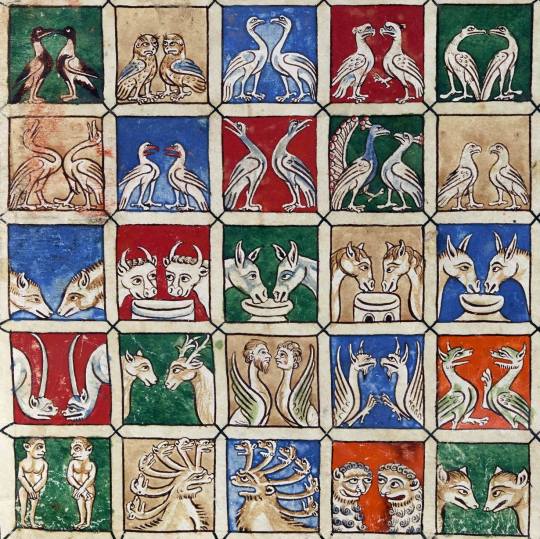
Noah’s Ark from the Beatus of Liébana, Commentaria in Apocalypsin - 12 Century Spain or France 12th - John Rylands University Library
2 notes
·
View notes
Text
Beato de Liébana: catálogo de Beatos ilustrados comentarios al Apocalipsis y estudio de los Beatos de Ginebra
Martin, Therese, y John Williams. Visions of the End in Medieval Spain: Catalogue of Illustrated Beatus Commentaries on the Apocalypse and Study of the Geneva Beatus. Amsterdam University Press, 2017. https://muse.jhu.edu/pub/315/oa_monograph/book/66670.
Este es el primer estudio que reúne las veintinueve copias existentes del Comentario medieval al Apocalipsis, escrito originalmente por el…
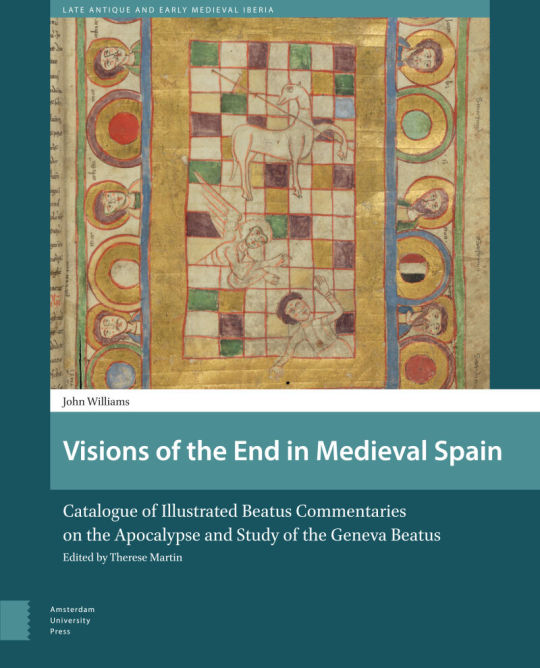
View On WordPress
0 notes
